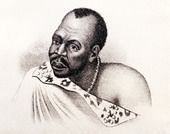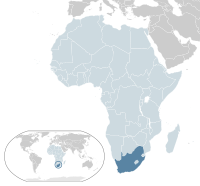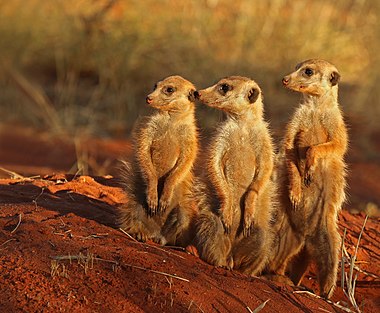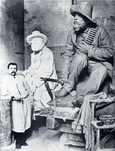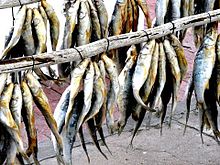Wikipedia portal for content related to South Africa
Welcome to the
South Africa
Portal
Unity in Diversity
Introduction
Flag of South Africa
The Republic of South Africa Namibia , Botswana , Zimbabwe , Mozambique , and Eswatini , and entirely surrounds Lesotho .
Chief Hintsa OF The Gcaleka Xhosa South Africa has the largest population of people of European descent in Africa, one of the largest Indian population outside of Asia , as well as the largest Coloured (of mixed European, Asian and African descent) community in Africa, making it one of the most ethnically diverse countries on the continent. Racial and ethnic strife between the black majority and the white minority have played a large part in the country's history and politics . The National Party began introducing the policy of apartheid after winning the general election of 1948 ; however, it was the same party under the leadership of F.W. de Klerk who started to dismantle it in 1990 after a long struggle by the black majority, as well as many white, coloured and Indian South Africans.
The country is one of the few in Africa never to have had a coup d'état , and regular free and fair elections have been held since 1994 , making it a regional power and among the most stable and liberal democracies in Africa.
South Africa is ranked as an upper-middle income economy by the World Bank . It has the second largest economy in Africa after Nigeria , and the 34th-largest in the world. By purchasing power parity , South Africa has the 7th highest per capita income in Africa. Although being the second largest economy, South Africa has the most sophisticated economy in the continent, with modern infrastructure common throughout the country. The country is considered to be a newly industrialized country according to the World Bank classifications.
The San peoples Saan ), or Bushmen , are the members of any of the indigenous hunter-gatherer cultures of southern Africa, and the oldest surviving cultures of the region. Their recent ancestral territories span Botswana , Namibia , Angola , Zambia , Zimbabwe , Lesotho , and South Africa .
The San speak, or their ancestors spoke, languages of the
Khoe ,
Tuu , and
Kxʼa language families, and can be defined as a people only in contrast to neighboring pastoralists such as the
Khoekhoe and descendants of more recent waves of immigration such as the
Bantu ,
Europeans , and
Asians . (
Full article... )
List of selected articles
WikiProjects
This is a Good article , an article that meets a core set of high editorial standards. The common eland Taurotragus oryx southern eland or eland antelope , is a large-sized savannah and plains antelope found in East and Southern Africa . An adult male is around 1.6 m (5.2 ft) tall at the shoulder (females are 20 cm (7.9 in) shorter) and can weigh up to 942 kg (2,077 lb) with a typical range of 500–600 kg (1,100–1,300 lb), 340–445 kg (750–981 lb) for females).
It is the second-largest antelope in the world, being slightly smaller on average than the
giant eland . It was scientifically described by
Peter Simon Pallas in 1766. (
Full article... )
Anton van Wouw (20 November 1862,
Driebergen - 30 July 1945,
Pretoria ) was a
Dutch -born sculptor regarded as the father of
South African sculpture .
Van Wouw decided to move to the developing city of Pretoria at the age of 28 and waited for ten years to receive his first commission. This was from financier Sammy Marks to create a monumental statue of Paul Kruger , which stands on Church Square.
During his time spent in the wilderness he developed a great admiration for the Boer nation. This also influenced his artistic development a great deal. He identified with the struggles and hopes of these people and this commitment was reflected in his work.
A great deal of his work, although representational, captures the rugged and emotional essence of his subjects. One of his most notable pieces of work is the figure of a woman used in the Women’s Monument near Bloemfontein . He collaborated on this with the architect Frans Soff. He was also responsible for the less successful figure of a woman incorporated into the Voortrekker Monument near Pretoria, a powerful bust of General Christiaan de Wet and the statue of Louis Botha in Durban .
He also portrayed indigenous peoples and among these smaller sculptures some of his finest work can be found. They are much less formal than his larger work and are appealing in their vivid and lifelike facial expressions.
Bokkoms (or
bokkems ) is whole, salted and dried
mullet (more specifically the Southern mullet,
Chelon richardsonii , a type of fish commonly known in the Western Cape of South Africa as "harders"), and is a well-known delicacy from the
West Coast region of South Africa. This salted fish is dried in the sun and wind and is eaten after peeling off the skin. In some cases it is also
smoked . It is sometimes referred to as "fish
biltong ". (
Full article... )
List of selected fare/cuisine articles
No one is born hating another person because of the colour of his skin, or his background, or his religion. People must learn to hate, and if they can learn to hate, they can be taught to love, for love comes more naturally to the human heart than its opposite.
Baviaanskloof Mega Reserve
The Baviaanskloof - (Dutch for “Valley of Baboons”)
The following are images from various South Africa-related articles on Wikipedia.
Image 1 Meat on a traditional South African
braai (from
Culture of South Africa )
Image 3 Statue of Bartolomeu Dias at the High Commission of South Africa in London. He was the first European navigator to sail around the southernmost tip of Africa. (from
History of South Africa )
Image 6 Church on
Greenmarket Square in Cape Town, South Africa with a banner memorialising the Marikana massacre (from
History of South Africa )
Image 7 Looking out over the floodplains of the Luvuvhu River (right) and the Limpopo River (far distance and left) (from
History of South Africa )
Image 8 Generals Smuts (right) and Botha were members of the British
Imperial War Cabinet during World War I. (from
History of South Africa )
Image 9 Boer
Voortrekkers depicted in an early artist's rendition (from
History of South Africa )
Image 10 Union Buildings , government administrative centre, Pretoria,
c. 1925 (from
History of South Africa )
Image 11 "For use by white persons" – sign from the apartheid era (from
History of South Africa )
Image 12 An account of the first
trekboers (from
History of South Africa )
Image 13 Cecil John Rhodes, co-founder of De Beers Consolidated Mines at Kimberley (from
History of South Africa )
Image 14 Groot Constantia , the oldest
wine estate in South Africa, was founded in 1685 by
Simon van der Stel . The
South African wine industry (New World wine) is among the lasting legacy of the
VOC era . The recorded
economic history of South Africa began with the VOC period. (from
History of South Africa )
Image 15 The
British Empire is red on the map, at its territorial zenith in the late 1910s and early 1920s. (
India highlighted in purple.) South Africa, bottom centre, lies between both halves of the Empire. (from
History of South Africa )
Image 17 King Moshoeshoe with his advisors (from
History of South Africa )
Image 18 Simon's Town harbour and naval base in South Africa were used by the Allies during World War II. (from
History of South Africa )
Image 19 The
Castle of Good Hope (
Kasteel de Goede Hoop in Dutch), Cape Town. Founded officially in 1652,
Kaapstad /Cape Town is the oldest
urban area in South Africa. (from
History of South Africa )
Image 20 Indian indentured labourers arriving in Durban (from
History of South Africa )
Image 22 Map of the black homelands in South Africa at the end of apartheid in 1994 (from
History of South Africa )
Image 23 View of
Table Bay with ships of the Dutch East India Company (VOC), c. 1683. (from
History of South Africa )
Image 24 Harry Smith (from
History of South Africa )
Image 25 Replica of an
East Indiaman of the
Dutch East India Company /
United East Indies Company (VOC). The Dutch East India Company was a major force behind the (c. 1590s–1720s) and
Netherlandish cartography (c. 1570s–1670s). (from
History of South Africa )
Image 26 Daniel François Malan , National Party leader from 1934 to 1953 (from
History of South Africa )
Image 28 Johannesburg before gold mining transformed it into a bustling modern city (from
History of South Africa )
Image 29 Flag of the South African Republic , often referred to as the
Vierkleur (meaning four-coloured) (from
History of South Africa )
Image 30 Shaka Zulu in traditional
Zulu military garb (from
History of South Africa )
Image 31 An array of traditional South African cuisine (from
Culture of South Africa )
Image 32 Oracles of the Pink Universe by Simphiwe Ndzube, 2021 (from
Culture of South Africa )
Image 33 Gateway to the
Castle of Good Hope , the oldest building in South Africa (from
Culture of South Africa )
Image 34 Emily Hobhouse campaigned against the appalling conditions of the
British concentration camps in South Africa, thus influencing British public opinion against the war. (from
History of South Africa )
Image 35 Painting of the Sharpeville massacre of March 1960 (from
History of South Africa )
Image 36 Regional geography during the period of the Anglo–Boer wars:
South African Republic /Transvaal
Orange Free State British
Cape Colony Natal Colony (from
History of South Africa )
Image 37 King
Cetshwayo (ca. 1875) (from
History of South Africa )
Image 38 Jan van Riebeeck , first Commander of the Dutch East India Company colony (from
History of South Africa )
Image 39 The rise of the Zulu Empire
under Shaka forced other chiefdoms and clans to flee across a wide area of southern Africa. Clans fleeing the Zulu war zone
included the
Soshangane ,
Zwangendaba ,
Ndebele ,
Hlubi ,
Ngwane , and the
Mfengu . Some clans were caught between the Zulu Empire and advancing
Voortrekkers and
British Empire such as the
Xhosa . (from
History of South Africa )
Image 40 Nicolaas Waterboer, Griqualand ruler, 1852–1896 (from
History of South Africa )
Image 42 The
statue of
Jan van Riebeeck , the founder of
Cape Town , in Heerengracht Street. (from
History of South Africa )
Image 43 Frederik W. de Klerk and
Nelson Mandela , two of the driving forces in ending apartheid (from
History of South Africa )
Topics
Categories
Category puzzle Select [►] to view subcategories
Related portals
Recognized content
New articles
This list was generated from
these rules . Questions and feedback
are always welcome ! The search is being run daily with the most recent ~14 days of results.
Note: Some articles may not be relevant to this project.
Rules | Match log | Results page (for watching) | Last updated: 2024-06-07 22:41 (UTC)
Note : The list display can now be customized by each user. See List display personalization for details.
Feya Faku (edit | talk | history | links | watch | logs | tools )Bobbyshabangu (talk · contribs · new pages (1) Umsinde Emoyeni Wind Power Station (edit | talk | history | links | watch | logs | tools )SiniyaEdita (talk · contribs · new pages (11) 2024 KwaZulu-Natal provincial election (edit | talk | history | links | watch | logs | tools )RayneVanDunem (talk · contribs · new pages (11) Shimza (DJ) (edit | talk | history | links | watch | logs | tools )Colanao Khod (talk · contribs · new pages (2) List of fossil stromatolites (edit | talk | history | links | watch | logs | tools )Lord.of.the.Proterozoic (talk · contribs · new pages (7) Israeli war crimes in the Israel–Hamas war (edit | talk | history | links | watch | logs | tools )CarmenEsparzaAmoux (talk · contribs · new pages (3) 2024 South African provincial elections (edit | talk | history | links | watch | logs | tools )Ornithoptera (talk · contribs · new pages (4) Results of the 2024 South African general election (edit | talk | history | links | watch | logs | tools )Ornithoptera (talk · contribs · new pages (4) List of international trips made by Jiang Zemin (edit | talk | history | links | watch | logs | tools )The Account 2 (talk · contribs · new pages (7) Matthew Chaskalson (edit | talk | history | links | watch | logs | tools )Jlalbion (talk · contribs · new pages (2) Pilbaria (edit | talk | history | links | watch | logs | tools )Lord.of.the.Proterozoic (talk · contribs · new pages (7) Higher health (edit | talk | history | links | watch | logs | tools )Derek J Moore (talk · contribs · new pages (1)
David Bilchitz (edit | talk | history | links | watch | logs | tools )Jlalbion (talk · contribs · new pages (2) Lulu Rasebotsa (edit | talk | history | links | watch | logs | tools )SiniyaEdita (talk · contribs · new pages (11) Chuene Morifi (edit | talk | history | links | watch | logs | tools )Mcwamcwa (talk · contribs · new pages (10) Aesopus algoensis (edit | talk | history | links | watch | logs | tools )JoJan (talk · contribs · new pages (46) African Barter Company (edit | talk | history | links | watch | logs | tools )RandomMe98 (talk · contribs · new pages (13) June 2024 South African storm complex (edit | talk | history | links | watch | logs | tools )Noble Attempt (talk · contribs · new pages (7) R511 (edit | talk | history | links | watch | logs | tools )A bit iffy (talk · contribs · new pages (26) Shadowland (song) (edit | talk | history | links | watch | logs | tools )Tbhotch (talk · contribs · new pages (28) 2024 Gauteng provincial election (edit | talk | history | links | watch | logs | tools )RayneVanDunem (talk · contribs · new pages (11) Khaled B. Letaief (edit | talk | history | links | watch | logs | tools )Ray aq (talk · contribs · new pages (2)
Hope4SA (edit | talk | history | links | watch | logs | tools )Greenman (talk · contribs · new pages (3) SEW (edit | talk | history | links | watch | logs | tools )Oshin2024 (talk · contribs · new pages (1) Emmanuel Mwambulukutu (edit | talk | history | links | watch | logs | tools )Eastmain (talk · contribs · new pages (7) SADF (disambiguation) (edit | talk | history | links | watch | logs | tools )TheNuggeteer (talk · contribs · new pages (28) Chennai Super Kings Cricket (edit | talk | history | links | watch | logs | tools )Magentic Manifestations (talk · contribs · new pages (14) A Cabinet Secret (edit | talk | history | links | watch | logs | tools )Perry Middlemiss (talk · contribs · new pages (3) 2024–25 Olympiacos F.C. season (edit | talk | history | links | watch | logs | tools )Drakoulis (talk · contribs · new pages (1) ADEC (edit | talk | history | links | watch | logs | tools )DividedFrame (talk · contribs · new pages (24) SRWP (edit | talk | history | links | watch | logs | tools )DividedFrame (talk · contribs · new pages (24) South African Electoral Amendment Bill (edit | talk | history | links | watch | logs | tools )Tumbuka Arch (talk · contribs · new pages (77) Tana Pistorius (edit | talk | history | links | watch | logs | tools )DrThneed (talk · contribs · new pages (18) Whites Only: Ade's Extremist Adventure (edit | talk | history | links | watch | logs | tools )CardiffProds (talk · contribs · new pages (2)
Miscanthidium (edit | talk | history | links | watch | logs | tools )Tom Radulovich (talk · contribs · new pages (78) Beryl Ferguson (edit | talk | history | links | watch | logs | tools )Moondragon21 (talk · contribs · new pages (52) Ernest in the Army (edit | talk | history | links | watch | logs | tools )Udar55 (talk · contribs · new pages (1) Tim Vieira (edit | talk | history | links | watch | logs | tools )Unknown Temptation (talk · contribs · new pages (26) SDC Open (edit | talk | history | links | watch | logs | tools )Derlinus (talk · contribs · new pages (11) Schoenefeldiella (edit | talk | history | links | watch | logs | tools )Tom Radulovich (talk · contribs · new pages (78) Love Island: All Stars (edit | talk | history | links | watch | logs | tools )庄育航 (talk · contribs · new pages (3) The Fix (2024 film) (edit | talk | history | links | watch | logs | tools )Starklinson (talk · contribs · new pages (6) Vuyiswa Ramokgopa (edit | talk | history | links | watch | logs | tools )Greenman (talk · contribs · new pages (3) Nkosinathi Sibanyoni (edit | talk | history | links | watch | logs | tools )H-Hurry (talk · contribs · new pages (7) Patricia Ochan Okiria (edit | talk | history | links | watch | logs | tools )Shanurah Yeko (talk · contribs · new pages (2)
Nunu Ntshingila-Njeke (edit | talk | history | links | watch | logs | tools )Emmanuella643 (talk · contribs · new pages (1) Libbie Janse van Rensburg (edit | talk | history | links | watch | logs | tools )Sports7s (talk · contribs · new pages (4) Lapeirousia oreogena (edit | talk | history | links | watch | logs | tools )Ornithoptera (talk · contribs · new pages (4) List of military equipment used by UMkhonto we Sizwe (edit | talk | history | links | watch | logs | tools )Katangais (talk · contribs · new pages (1) 2000 African Badminton Championships (edit | talk | history | links | watch | logs | tools )Fanminton (talk · contribs · new pages (7) Marius Mostert (edit | talk | history | links | watch | logs | tools )Jevansen (talk · contribs · new pages (114) Portland Manor, Knysna (edit | talk | history | links | watch | logs | tools )M J Hurter (talk · contribs · new pages (6) Farleigh, Western Cape (edit | talk | history | links | watch | logs | tools )M J Hurter (talk · contribs · new pages (6) Makoma Mohale (edit | talk | history | links | watch | logs | tools )TshepoR (talk · contribs · new pages (2)
England women's cricket team in South Africa in 2003–04 (edit | talk | history | links | watch | logs | tools )Hey man im josh (talk · contribs · new pages (308) 2006–07 Associates Triangular Series in South Africa (edit | talk | history | links | watch | logs | tools )Hey man im josh (talk · contribs · new pages (308) Lubango dungeons (edit | talk | history | links | watch | logs | tools )Shikoha Tautiko (talk · contribs · new pages (2) Schoenoplectus triqueter (edit | talk | history | links | watch | logs | tools )Cremastra (talk · contribs · new pages (18) Touwsranten (edit | talk | history | links | watch | logs | tools )M J Hurter (talk · contribs · new pages (6) 2002 African Badminton Championships (edit | talk | history | links | watch | logs | tools )Fanminton (talk · contribs · new pages (7) Albert Kangwanda (edit | talk | history | links | watch | logs | tools )Geschichte (talk · contribs · new pages (7) Mduduzi Shabalala (edit | talk | history | links | watch | logs | tools )Geschichte (talk · contribs · new pages (7) 2004 African Badminton Championships (edit | talk | history | links | watch | logs | tools )Fanminton (talk · contribs · new pages (7) Woodville, Western Cape (edit | talk | history | links | watch | logs | tools )M J Hurter (talk · contribs · new pages (6) 2010 Royal Challengers Bangalore season (edit | talk | history | links | watch | logs | tools )Sammi Brie (talk · contribs · new pages (132) Greg Goosen (edit | talk | history | links | watch | logs | tools )Jevansen (talk · contribs · new pages (114) Macaranga capensis (edit | talk | history | links | watch | logs | tools )Tom Radulovich (talk · contribs · new pages (78)
{{{1}}}
Associated Wikimedia
The following Wikimedia Foundation sister projects provide more on this subject:
Commons
Wikibooks
Wikidata
Wikinews
Wikiquote
Wikisource
Wikiversity
Wikivoyage
Wiktionary
Purge server cache
